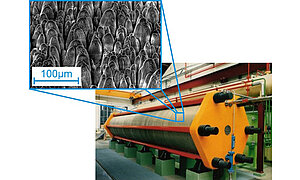
GreenH2
Co-funded by the Federal Ministry for Economic Affairs and Energy (BMWi)
Duration: June 2015 – December 2019
“The energy transition is our avenue into a secure, environmentally friendly, and economically successful future. We have already done a fair bit of the work: renewable energy is now Germany's most important energy source for electricity. And not only are we increasingly relying on green energy - we are also using it more economically” (www.bmwi.de). To achieve these ambitious goals, a great deal of research and development has to be done in the forthcoming years. One open problem is an efficient way to store renewable energy in times of overcapacity - water electrolysis is one promising option to solve this dilemma.
Within the research project Green H2, Fraunhofer HHI, Fraunhofer IFAM and four German companies are working on the next development step for this technique. Novel electrode materials enabling higher current densities, bearing significant load fluctuations (due to use of wind energy e.g.), and reaching for higher efficiency and lifetime will be focus of the research part; achieving a specifically low cost production of these samples at high output is the main development step. A novel nano- and microstructuring technique using a femtosecondlaser-based surface modification process at high repetition rates will be exploited to achieve these goals.